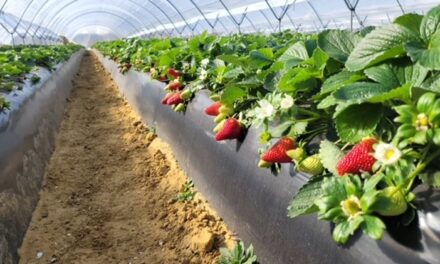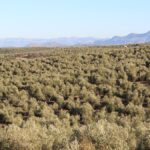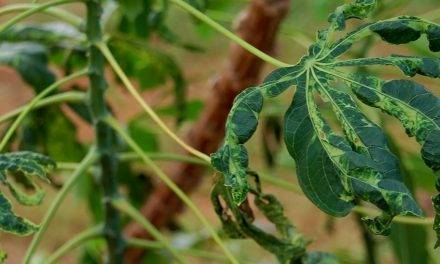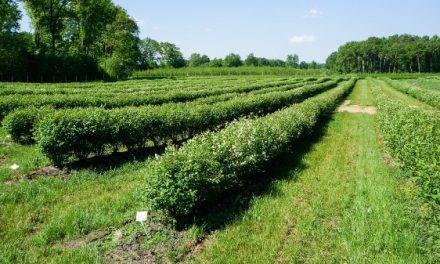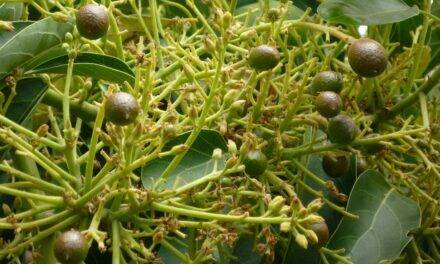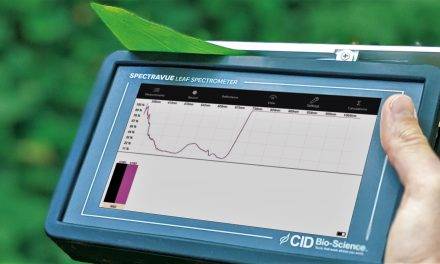
Hygiene management in vegetable production to control ToBRFV in tomato
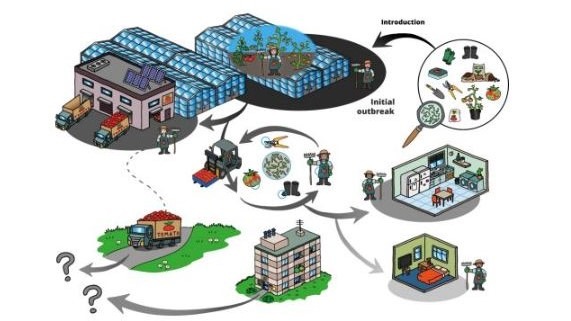
Hygiene management in vegetable production is key for the control of Tomato brown rugose fruit virus, ToBRFV
Jens Ehlers, jens.ehlers@menno.de
INFOMMERCIAL. The Tomato brown rugose fruit virus (ToBRFV) has been detected in more than 35 countries worldwide since its first occurrence in Israel and Jordan almost 10 years ago and has caused economic losses which threaten the existence of many growers. In Spain and other neighbouring countries, the dangerous viral disease has been repeatedly detected in tomato farms. Due to its long persistence, high stability, easy mechanical spread and severe effects, ToBRFV is classified as a quarantine pest.
Because of its great economic importance for farms, scientists at the Humboldt-Universität zu Berlin investigated the question of whether and to what extent the virus is carried in an affected commercial tomato farm and what role humans play in this context. The results of systematic sampling in a German production facility affected by a ToBRFV outbreak in 2022 are impressive.
Both work clothes, gloves and shoe soles were highly contaminated with ToBRFV after one working day, so that humans as “superspreaders” contribute significantly to the rapid spread of the pathogen in the greenhouse and the direct production surroundings.
Research on propagation
In order to investigate whether and, if so, where the virus can be spread internally during ongoing tomato production, hundreds of wipe samples with cotton swabs were taken from numerous surfaces on the entire farm area. ToBRFV was detected in different parts of the farm, such as the greenhouses, the packaging hall, but also on surfaces of the accommodation, and it could be shown that the viruses found were still infectious. As expected, surfaces in the greenhouse such as roads, groundcovers and doormats were most frequently contaminated with ToBRFV.
Individual objects such as the doormats or the cutting tool had even tested positive for ToBRFV in all samples taken. Not entirely surprisingly, surfaces in the packaging hall with many scales, tools and lift trucks also proved to be widely contaminated with the virus. However, the fact that almost 20 % of all samples from the communal accommodation were also contaminated with the virus is alarming. Door handles, light switches, kettles, TV remote controls and mattresses are just a few examples where infectious ToBRFV was still found.

Table 1: Where and in what frequency could ToBRFV be found in an affected farm?
Research on control
How can these results help us to improve the control of ToBRFV in the future? First of all, the results demonstrate how humans can carry stable plant viruses such as ToBRFV on the farm and on which surfaces ToBRFV can subsequently be found. Based on this, special cleaning and disinfection measures must be applied to eradicate ToBRFV from the farm and prevent its reintroduction.
Greenhouses and tunnels
At the end of the season, the greenhousesor foil tunnels have to be cleaned.
To do this, all surfaces that could potentially be contaminated with ToBRFV must first be cleaned to remove dirt contamination. The cleaning of the greenhouse/foil tunnels should be done from top to bottom, from back to front, preferably with warm water. Before the dirt dries again, the surfaces should be rinsed to create optimal conditions for effective disinfection.
ToBRFV-contaminated surfaces can now be disinfected by applying an approved disinfectant so that they are no longer a risk of infection. In another study by scientists at the Humboldt -Universität zu Berlin, it was shown that greenhouse surfaces highly contaminated with ToBRFV could be safely disinfected by foam application of 4 % MENNO Florades at an application rate of 0.4 l m-². Tomato growers thus have an approved and effective means of controlling this dangerous viral disease.
Personnel clothing
Besides sanitation measures at the end of the cultivation period, effective measures can already be taken during the vegetation period to prevent or reduce the risk of introduction and spread of ToBRFV. In further studies, specific cleaning and disinfection measures for personnel hygiene were investigated in order to be able to give you scientifically based recommendations for the control of stable plant pathogens.
(Work) clothing poses a high phytosanitary risk of spread. On the one hand, clothing is in constant contact with plants during cultivation measures, so that infected plant sap can easily be carried from plant to plant. On the other hand, the viruses in the plant sap can be soaked up into the fibres, persist there and then be reintroduced into the crop. This is possible even weeks or months later.
So how can viruses be safely inactivated on clothing without damaging it? Due to the high thermal inactivation point of tobamoviruses around 90 °C, a boil wash at just that temperature would be necessary to achieve thermal inactivation of ToBRFV. Such a high temperature can damage the clothing and requires a high energy input.
We investigated whether a chemical pre-cleaning of the clothes in an dipping step for 10 minutes:
i) can safely remove ToBRFV from the clothes
ii) if the resulting cleaning solution is contaminated with ToBRFV and
iii) if the resulting cleaning solution can be safely disinfected by adding a disinfectant.
The results are clear: both the textiles and the resulting cleaning solutions of the household detergents Spee and Vanish were highly contaminated with infectious ToBRFV after the dipping procedure.
In comparison, ToBRFV was almost completely removed from the textiles and cleaning solutions of the special cleaners MENNO HORTISEPTCLEAN Plus, FADEX H+ as well as the disinfectant MENNO Florades, meaning that there was no further risk of infection. Furthermore, the application of MENNO Florades into the contaminated solutions of the household detergents showed that the inactivation of ToBRFV is also successful in this media.
Based on these results and the enormous risk of spreading through contaminated clothing, we recommend that worn work clothes should be dipped in a wash container or similar for > 10 minutes at room temperature after a work day. The cleaners MENNO HORTISEPTCLEAN Plus, FADEX H+ as well as the disinfectant MENNO Florades can be used for the immersion treatment.
Afterwards, the clothes are removed from the washing container and washed in a conventional washing machine. The cleaning solution in the washing container can be reused for further dipping treatments of clothes or, by adding MENNO Florades to a target concentration of 4 %, can be used as a disinfectant solution for the disinfection of surfaces, walkways and other objects.
Footwear
In addition to clothing, footwear, especially shoe soles, are responsible for the spread of ToBRFV within a greenhouse. The results of studies on the decontamination of shoe soles show that adhering dirt and pathogens such as ToBRFV must first be mechanically removed from the shoe sole and the inactivation of the pathogens subsequently takes place in/on the disinfection mat. For the mechanical cleaning of the shoe soles, (rotating) brushes can be installed or the mechanical cleaning takes place by intensive treading on the disinfection mat.
In our investigations, we were able to show that a large part of the viruses was removed from the shoe soles by this measure and then reliably inactivated in the disinfection mat filled with 4 % MENNO Florades. A control variant filled with water highlights the need for an effective disinfectant. In the mat filled with water, Tomato brown rugose fruit virus accumulated and was still highly concentrated and infectious days after the trial.
The studies showed practical ways of transmission as well as specific cleaning and disinfection measures on the human “superspreader”. The measures presented are intended to support you in your personal, individual hygiene management and to help ensure that ToBRFV does not threaten your economic success.
The Figure on the top is an illustration of human-caused spread of ToBRFV across a tomato farm
For further information, please contact me directly or have a look at the original articles with the titles:
Ehlers, J.; Nourinejhad Zarghani, S.; Liedtke, S.; Kroschewski, B.; Büttner, C.; Bandte, M. Analysis of the Spatial Dispersion of Tomato Brown Rugose Fruit Virus on Surfaces in a Commercial Tomato Production Site. Horticulturae 2023, 9, 611. https://doi.org/10.3390/horticulturae9050611
Ehlers, J.; Nourinejhad Zarghani, S.; Kroschewski, B.; Büttner, C.; Bandte, M. Cleaning of Tomato brown rugose fruit virus (ToBRFV) from Contaminated Clothing of Greenhouse Employees. Horticulturae 2022, 8, 751. https://doi.org/10.3390/horticulturae8080751
Ehlers, J.; Nourinejhad Zarghani, S.; Kroschewski, B.; Büttner, C.; Bandte, M. Decontamination of Tomato Brown Rugose Fruit Virus-Contaminated Shoe Soles under Practical Conditions. Horticulturae 2022, 8, 1210. https://doi.org/10.3390/horticulturae8121210

